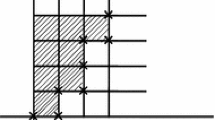Abstract
In this paper, we provide combinatorial meanings to two generalized basic series with the aid of associated lattice paths. These results produce two new classes of infinite 3-way combinatorial identities. Five particular cases are also discussed. These particular cases provide new combinatorial versions of Göllnitz–Gordon identities and Göllnitz identity. Seven q-identities of Slater and five q-identities of Rogers are further explored using the same combinatorial object. These results are an extension of the work of Goyal and Agarwal (Utilitas Math. 95 (2014) 141–148), Agarwal and Rana (Utilitas Math. 79 (2009) 145–155), and Agarwal (J. Number Theory 28 (1988) 299–305).






Similar content being viewed by others
References
Agarwal A K, Rogers–Ramanujan identities for \(n\)-color partitions, J. Number Theory 28 (1988) 299–305
Agarwal A K, Lattice paths and \(n\)-color partitions, Utilitas Mathematica 53 (1998) 71–80
Agarwal A K and Andrews G E, Rogers–Ramanujan identities for partitions with ‘\(N\) copies of \(N\)’, J. Combin. Theory Ser. A. 45(1) (1987) 40–49
Agarwal A K and Bressoud D M, Lattice paths and multiple basic hypergeometric series, Pac. J. Math. 136(2) (1989) 209–228
Agarwal A K and Goyal M, Lattice paths and Rogers identities, Open J. Discrete Math. 1 (2011) 89–95
Agarwal A K and Goyal M, New partition theoretic interpretations of Rogers–Ramanujan identities, Int. J. Combin. (2012) 6 pages, https://doi.org/10.1155/2012/409505
Agarwal A K and Rana M, New combinatorial versions of Göllnitz–Gordon identities, Utilitas Mathematica 79 (2009) 145–155
Agarwal A K and Rana M, On an extension of a combinatorial identity, Proc. Indian Acad. Sci. (Math. Sci.) 119(1) (2009) 1–7
Anand S and Agarwal A K, A new class of lattice paths and partitions with \(n\) copies of \(n\), Proc. Indian Acad. Sci. (Math. Sci.) 122(1) (2012) 23–39
Andrews G E, An introduction to Ramanujan’s “lost” notebook, Am. Math. Mon. 86 (1979) 89–108
Connor W G, Partition theorems related to some identities of Rogers and Watson, Trans. Am. Math. Soc. 214 (1975) 95–111
Ganesan Ghurumuruhan, Multiplicity of summands in the random partitions of an integer, Proc. Indian Acad. Sci. (Math. Sci.) 123(1) (2013) 101–143
Göllnitz H, Einfache partitionen (unpublished), Diplomarbeit W.S., Gotttingen (1960) 65
Göllnitz H, Partitionen unit differenzenbedingun-gen, J. Reine Angew. Math. 225 (1967) 154–190
Gordon B, Some continued fractions of the Rogers–Ramanujan type, Duke J. Math. 32 (1965) 741–748
Goyal M and Agarwal A K, Further Rogers–Ramanujan identities for \(n\)-color partitions, Utilitas Mathematica 95 (2014) 141–148
Goyal M and Agarwal A K, On a new class of combinatorial identities, ARS Combin. 127 (2016) 65–77
Mansour Toufik and Shattuck Mark, A statistic on \(n\)-color compositions and related sequences, Proc. Indian Acad. Sci. (Math. Sci.) 124(2) (2014) 127–140
Slater L J, Further identities of the Rogers–Ramanujan type, Proc. Lond. Math. Soc. 54 (1952) 147–167
Subbarao M V, Some Rogers–Ramanujan type partition theorems, Pac. J. Math. 120 (1985) 431–435
Author information
Authors and Affiliations
Corresponding author
Additional information
Communicating Editor: S D Adhikari
Rights and permissions
About this article
Cite this article
Agarwal, A.K., Goyal, M. On 3-way combinatorial identities. Proc Math Sci 128, 2 (2018). https://doi.org/10.1007/s12044-018-0378-3
Received:
Revised:
Accepted:
Published:
DOI: https://doi.org/10.1007/s12044-018-0378-3



